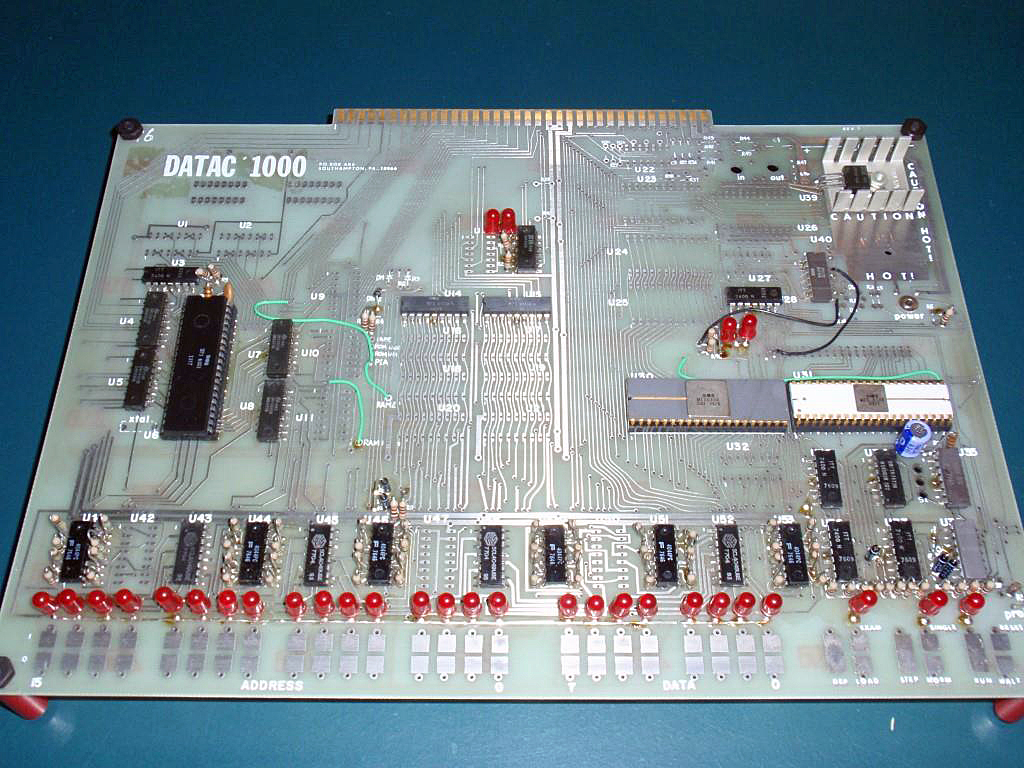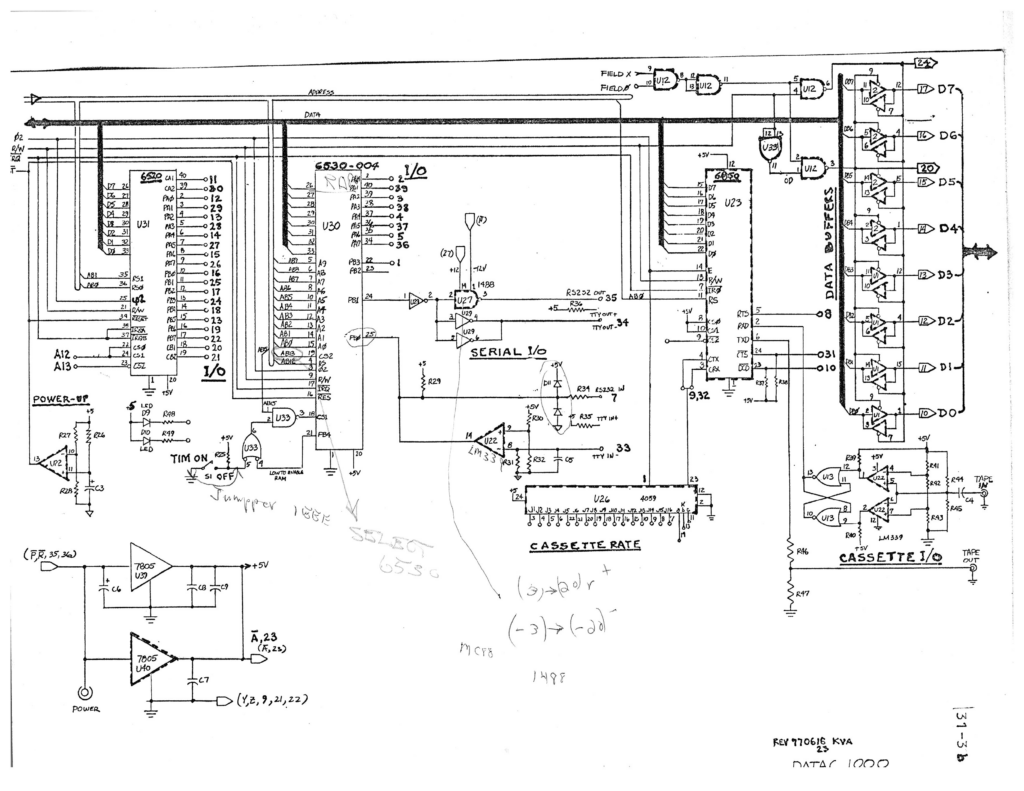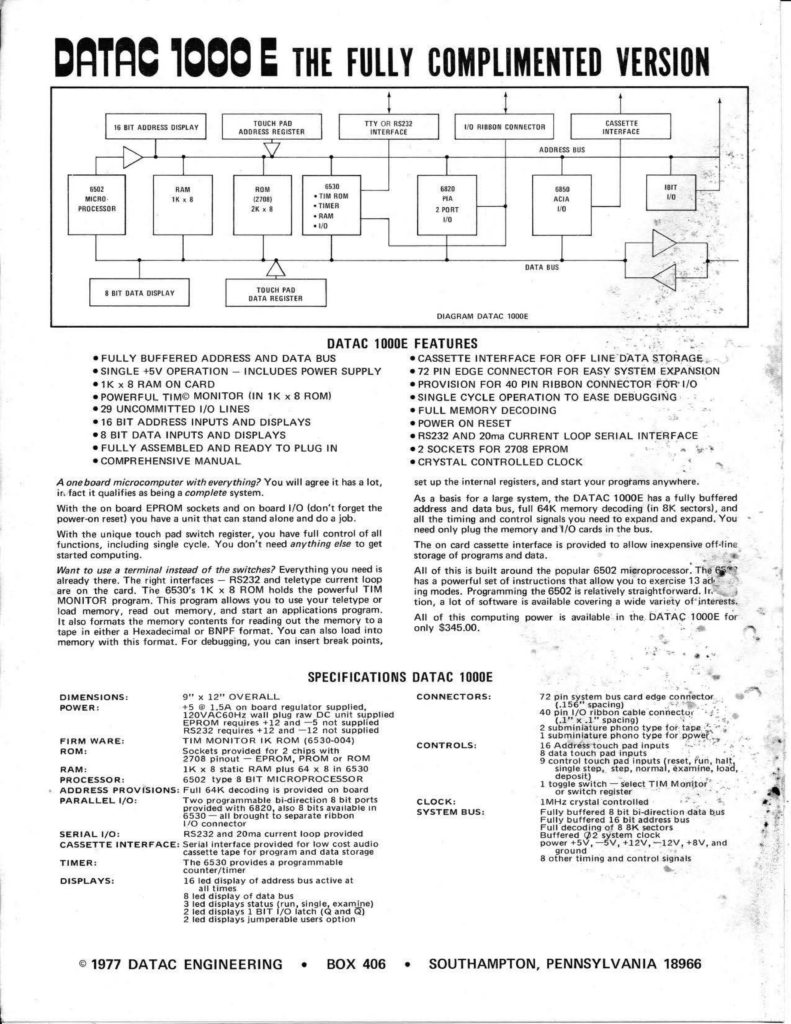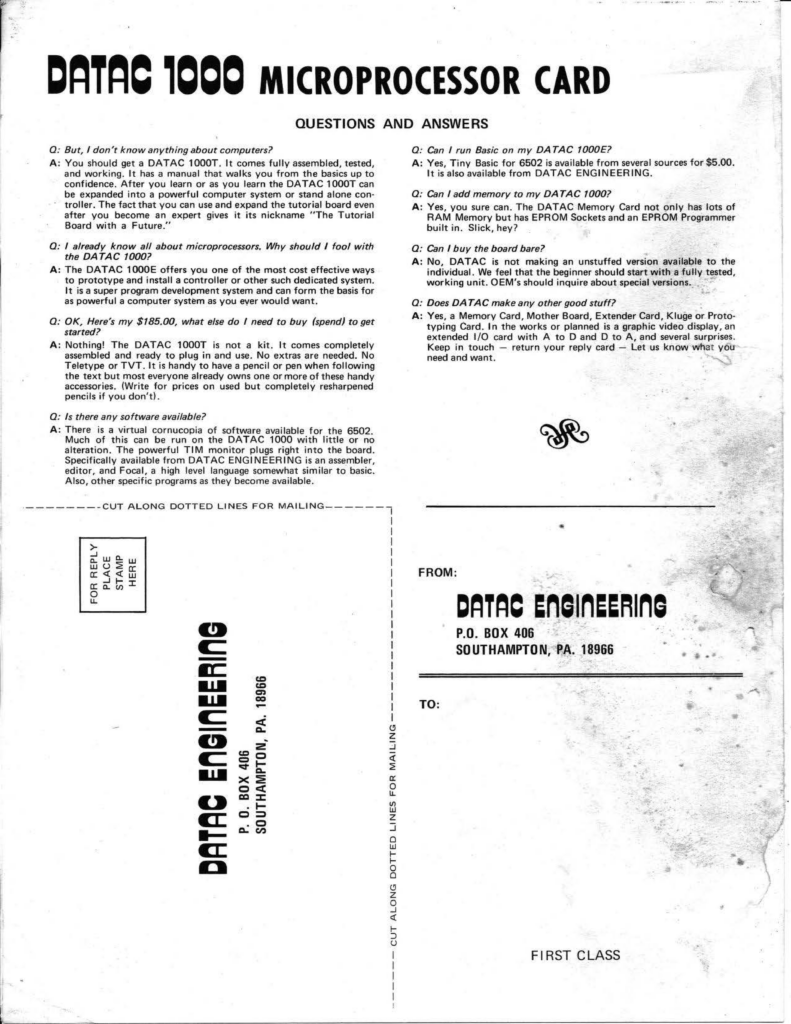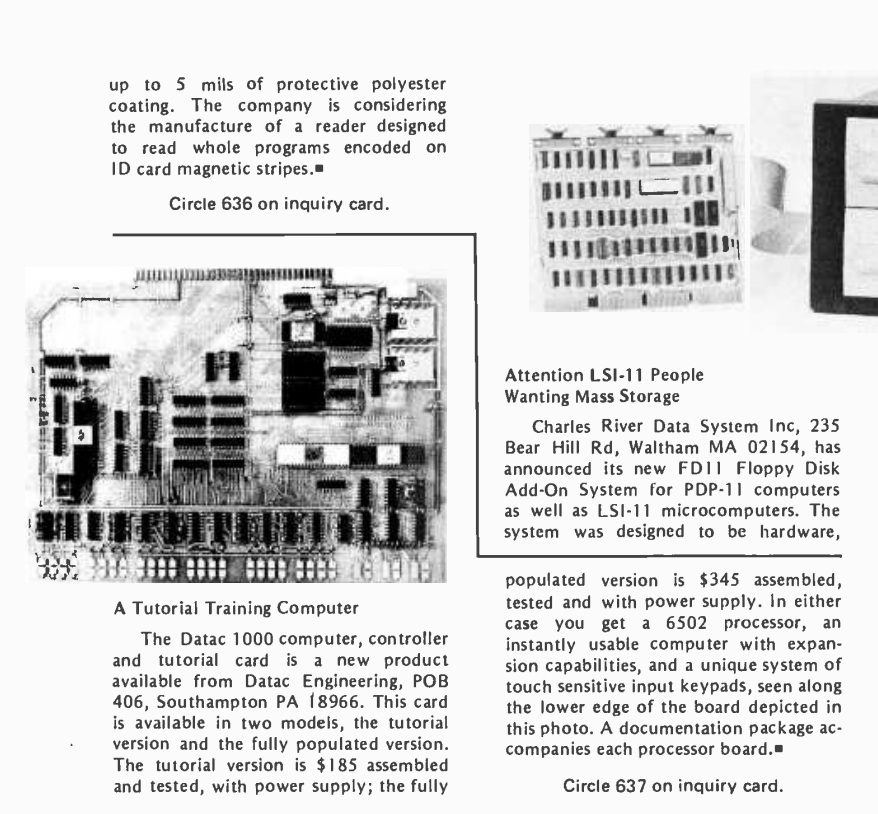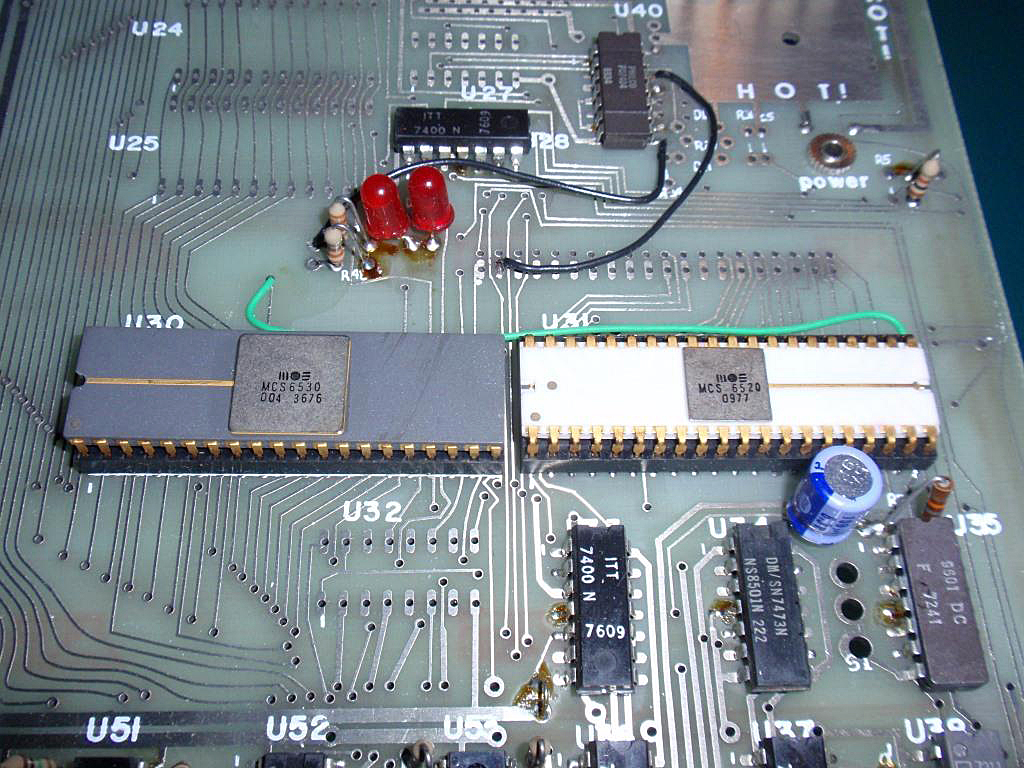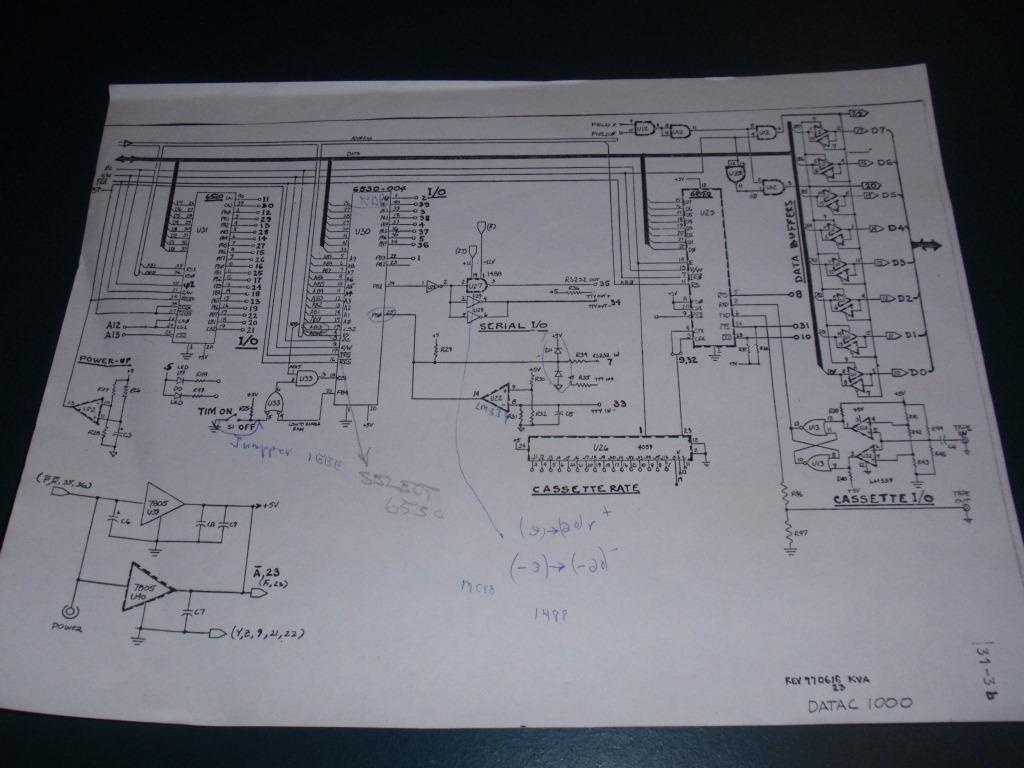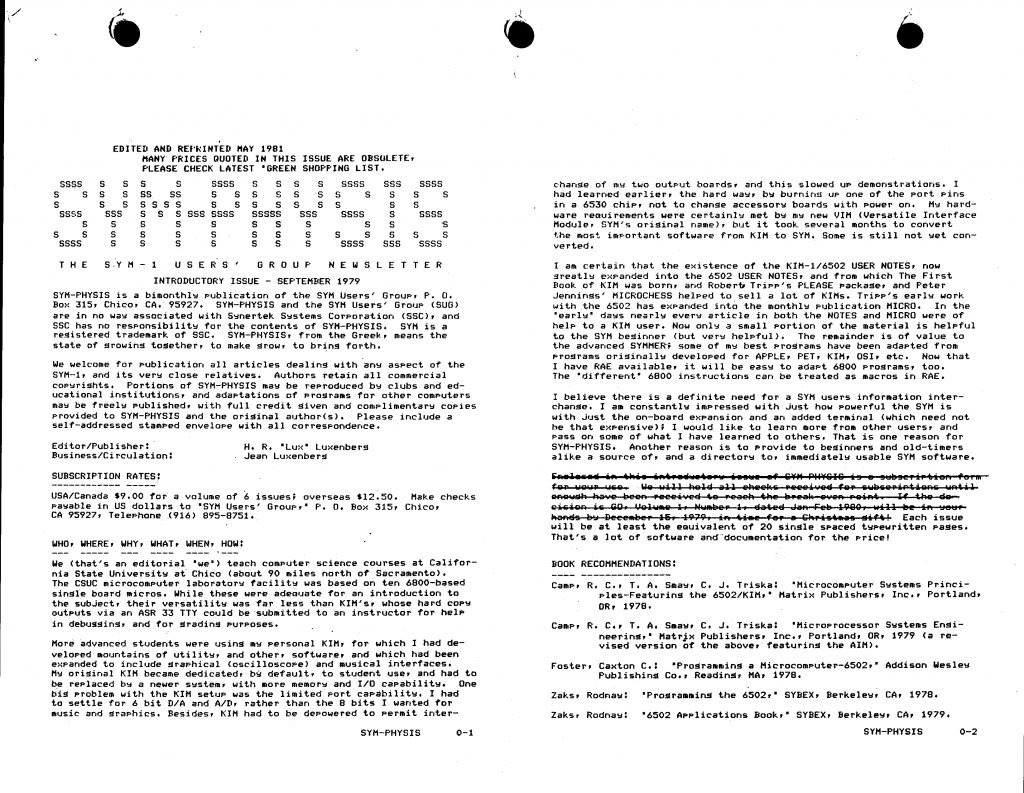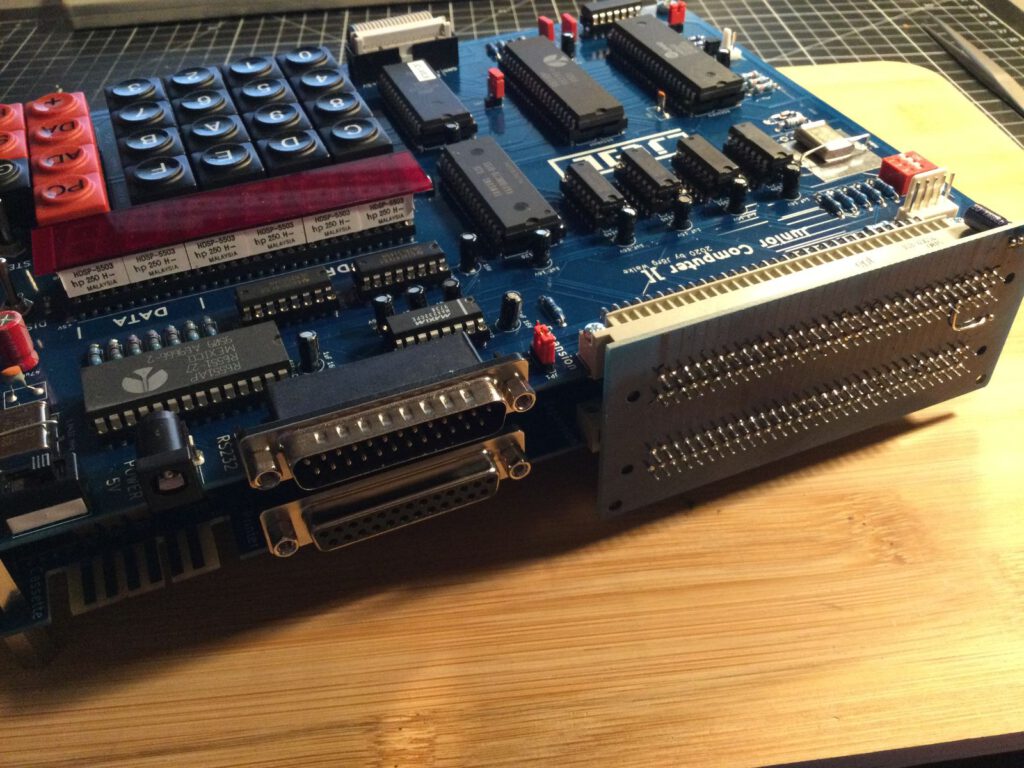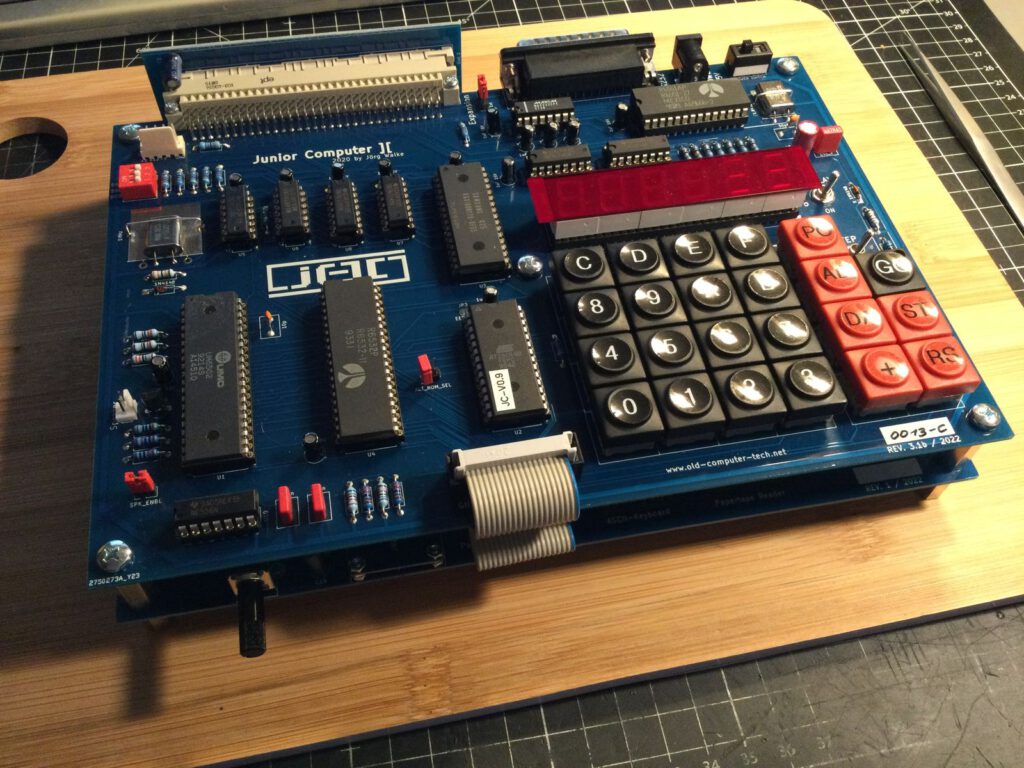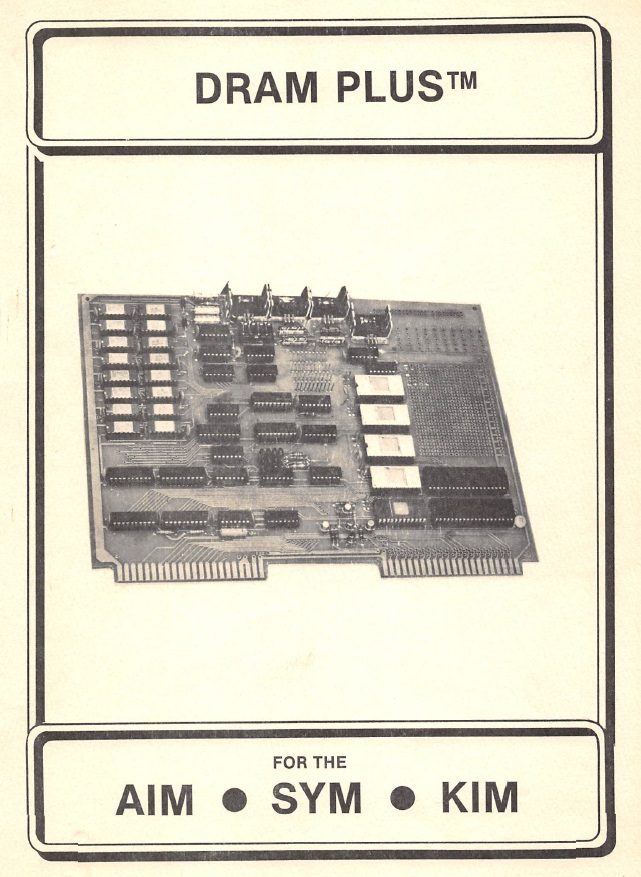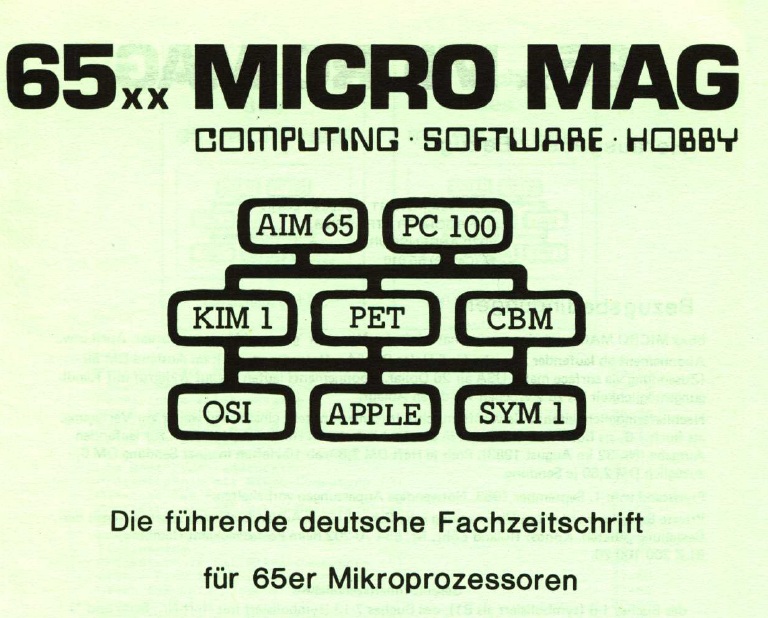Photos and information thanks to https://oldcomputermuseum.com and https://www.kennettclassic.com/
Category Archives: 6502
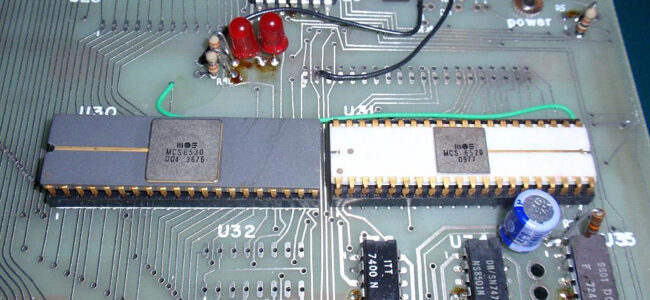
Datac 1000, a TIM 6502 SBC
The DATAC 1000, a single-board computer based upon a 6502 and a TIM RRIOT, designed in 1976 by Philadelphia Area Computer Society club members Carmen DiCamillo and Roland James.
This single board computer was premiered at the club’s August 1976 meeting in Atlantic City, NJ. Once “perfected,” the computer helped introduce many PACS members, and others,
to the field of microcomputers. The official manufacturer of this computer was Datac Engineering of Southampton, PA.
The computer was available in two models: the $185 “tutorial” version and the fully populated and tested version for $345.
In either case the 6502 CPU was included. Computer was instantly usable and featured expansion capabilities, touch sensitive input keypads and a documentation package.
The computer was so revolutionary that it was featured in Byte Magazine’s July 1977 edition.
Photos and information thanks to https://oldcomputermuseum.com and https://www.kennettclassic.com/ and intagecomputer.net
DATAC 1000 by Datac Engineering 1976
– CPU MOS 6502 1 MHz
– RAM 1K (2111 SRAM)
– RRIOT TIM 6530-004 for serial I/O and ROM
– I/O ports with a PIA 6520
– tape interface, bus expansion, serial (to connect to a terminal)
– Touch-sensitive pads 27 LEDs
– Power supply external 9 VDC PSU
Downloads:
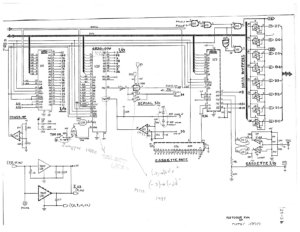 |
Datac 1000 schematic |
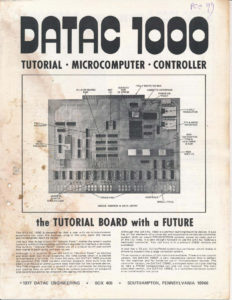 |
Datac 1000 brochure |
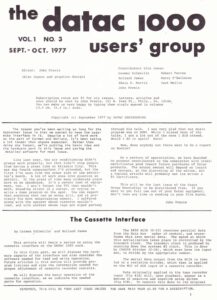 |
Datac 1000 User group 09 1977 |
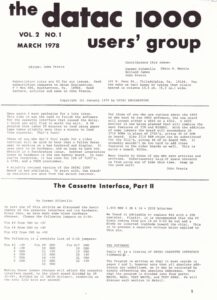 |
Datac 1000 User group 03 1978 |
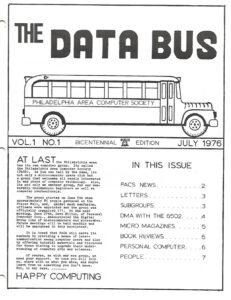 |
PACS The Data bus vol 1 no 1 July 1976 |
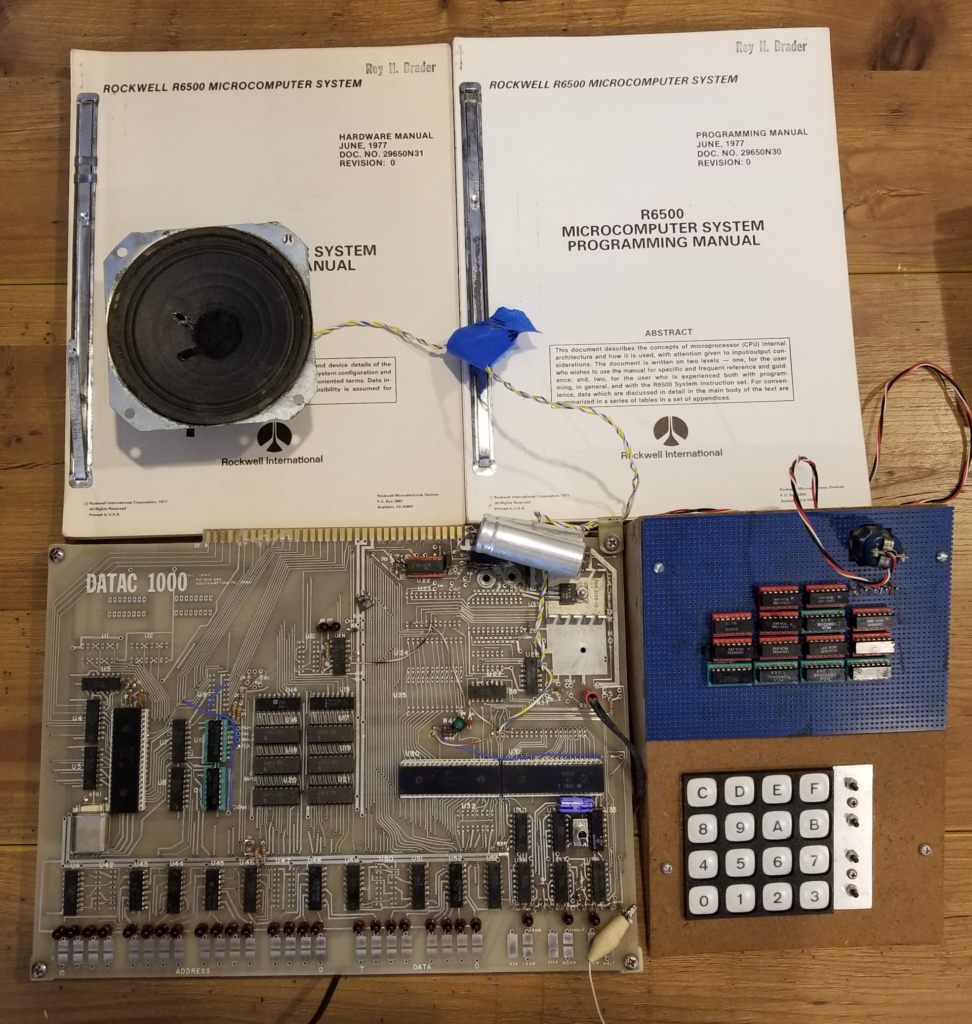
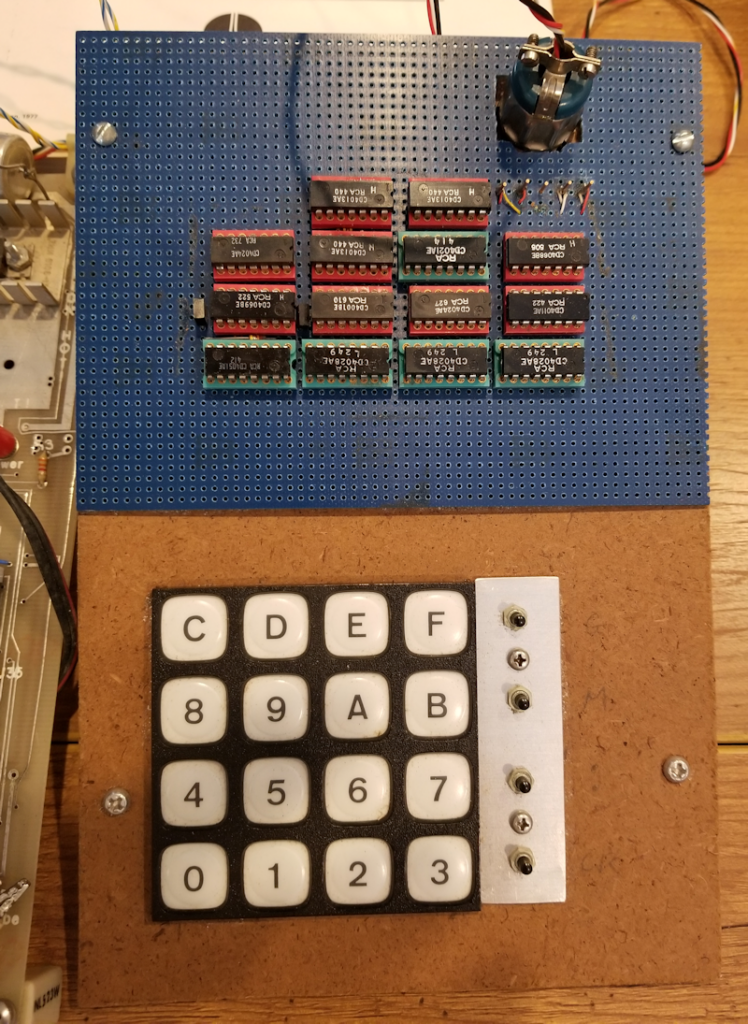
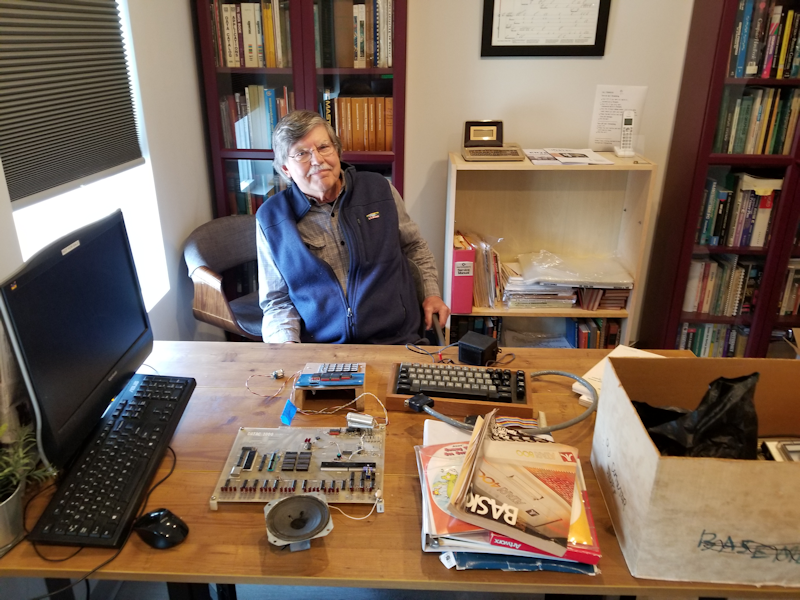
Roy Brade with his expanded Datac 1000
See also:
History of the TIM in the Jolt
Jolt software
Images of the Jolt
Jolt with a 74154 decoder
KIM-1 Simulator at version 1.1.4
The KIM-1 Simulator is now at version 1.1.4. Not much news, just some small steps. Windows executable is updated, Linux versions require compiling sources.
See also:
KIM-1 connectors: beware the Chinese cheap variants!
Magazines: Compute! and Compute II
All documents in the MTU pages are now clean and higher quality, about 50 new PDFs.
Focal-65 V3D for TIM and KIM-1
SYM-1 1541 DOS
A DOS for the SYM-1, based upon the Commodore 1541 System
See also
The DOS was sold by Ronald A. Jordan in 1984, who sold this DOS thru his company, Jordan & Associates. This 1541 DOS system was sold as object code on a cassette tape. For an additional fee he would burn an EPROM as well as provide the object code on cassette tape and for still another an additional fee, he would provide the source code on cassette tape.
The 1541 physical interface was also provided by Jordan and consisted of a very simple box with one 7416 hex inverter chip with the mating connectors for the SYM and Commodore 1541 Disk Drive.
The Commodore 1541 disk drive was affordable, around $300 in 1983. A logical choice at the time therefore, since the serial IEC bus is so easy to operate on a small 6502 SBC and the whole DOS included in the drive itself, avoiding a DOS for the SBC. Disadvantages of course are the slow IEC bus and nowadays the vintage character of the 1541 drive. Since there are alternative ‘1541 compatible drives made by hobbyist, with an SD as storage it is still interesting to add this to a SBC (SD2IEC, Pi1541 etc).
On this page all available information is collected about this 1541 DOS.
The information on the 1541 DOS is from these websites:
- Dallas Shell page on DOS for SYM-1
- Radiotools page on SYM-1
- SYM-1 Expansion Board Documentation – Galactic Studios
Added by me are the sources of the 1541 DOS, the scanned version was lost long ago on teh page of Dallas.. But I did keep a copy. In 2006 the source has been typed in by me in normal 6502 assembly.
The 1541 DOS package consists of a manual, a tape with 1541 DOS code and optionally a hardware interface tot the IEC of the Commodore 1541 and also optional source code on tape.
The 1541 DOS code is made up of interfacing code for the IEC bus, and integration for the Monitor, Basic and RAE. The fuctcionality is limited to showing directories, loading and saving memory, but no data file support. It ix possible to give to the 1541 drive ‘special’ commands, e.g. format a drive. More than one drive is supported.
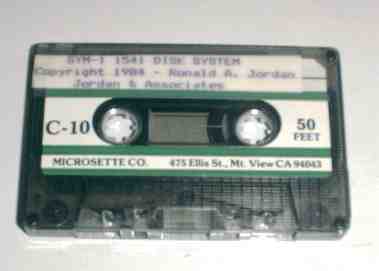
Hardware
The interface is simple, just an open collector TTL IC, 7416, 3 inputs and 3 outputs of the VIA 6522 to the IEC serial bus ATN, DATA and CLOCK and RESET
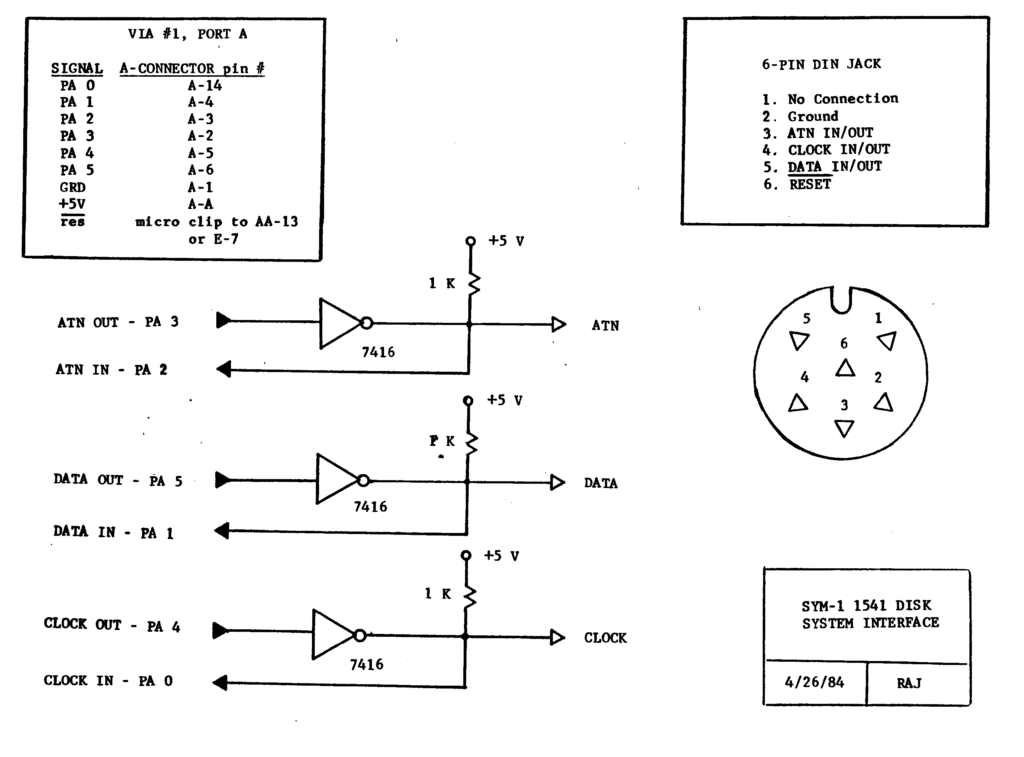
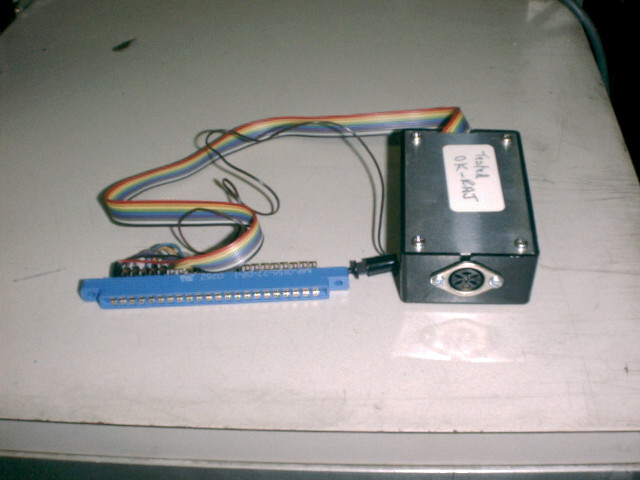
See also:
Software
Part is interface to the IEC bus (bit banging), the other parts are linking to Monitor, RAE and Basic.
Functionality offered:

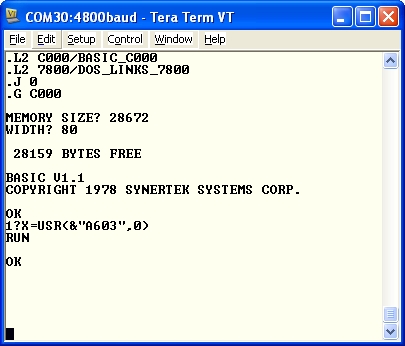
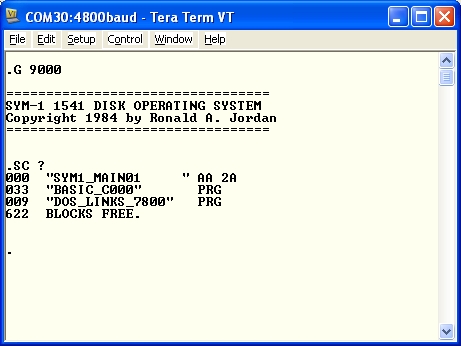
Downloads
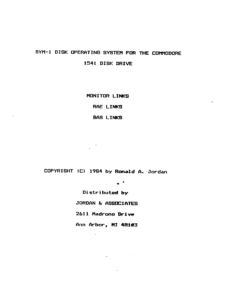
|
Original 1541 DOS documentation (cleaned up, complete) 1. SYM 1541 DOS Manual 2. Hardware interface circuit Design 3. Source of 1541 DOS, RAE Basic Monitor driver 4. Crossreference of software 5. Contents of Utility Disk |
| Cheat-Sheet.pdf | DOS 1541 short userguide for SYM-1, Monitor, RAE, Basic |
| 1541DOS_OBJ_PTAPE.TXT | DOS 1541 code for address $7000 (see notes below) |
| 1541DOS 9000.txt | DOS 1541 code for address $9000 (see notes below) |
| 1541dos.bin | 1541 DOS binary for address $9000 |
| sym1541.asm | 1541 DOS in TASM format (typed in from listing, not tested yet!) |
| 1541DOS_RAE.txt | 1541 DOS in RAE format |
Note
The object code assembled to run at $7000 is in SYM paper tape format. Note this code is assembled to run at $7000 but will load into $1000 from the paper tape load. The object code assembled at $9000 is also in SYM paper tape format. Same rules apply for loading etc.
See also:
History of the TIM in the Jolt
Jolt software
Images of the Jolt
Jolt with a 74154 decoder

SYM-Physis The SYM-1 Users’ Group newsletter
Published from issue 0 September 1979 until the last issue 17 Winter 1983
SYM-Physis Issue 0
SYM-Physis Issue 1
SYM-Physis Issue 2
SYM-Physis Issue 3
SYM-Physis Issue 4
SYM-Physis Issue 5-6
SYM-Physis Issue 7
SYM-Physis Issue 8
SYM-Physis Issue 9
SYM-Physis Issue 10
SYM-Physis Issue 11
SYM-Physis Issue 12
SYM-Physis Issue 13-14
SYM-Physis Issue 15
SYM-Physis Issue 16
SYM-Physis Issue 17
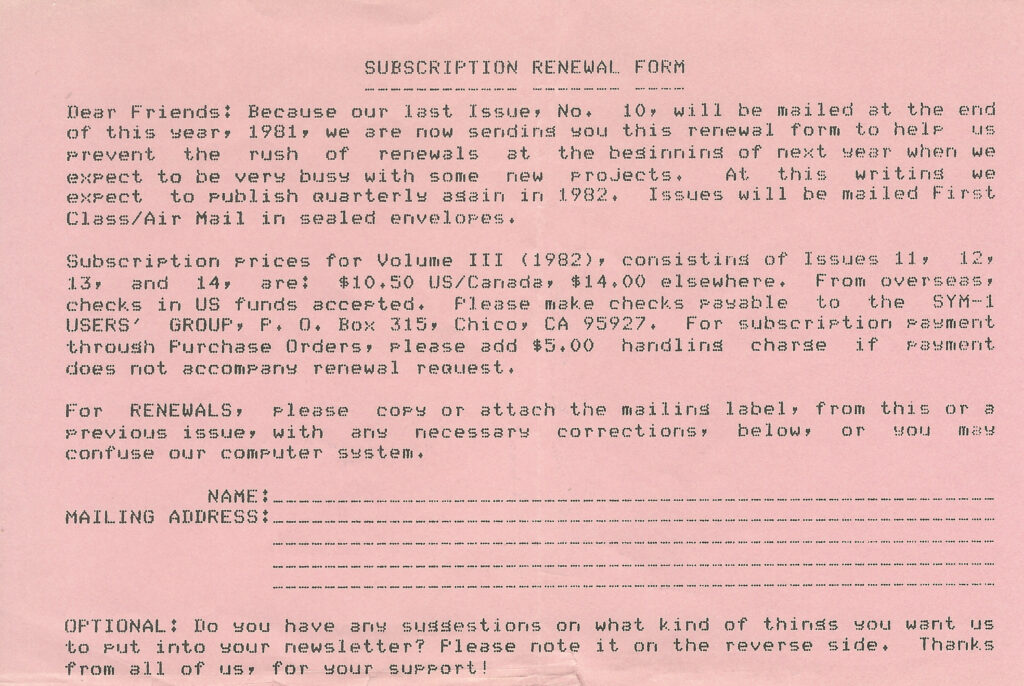
See also:
History of the TIM in the Jolt
Jolt software
Images of the Jolt
Jolt with a 74154 decoder
Junior Computer II
Written by 2021 by Joerg Walke, visit his webiste for the most actual version!
The Junior Computer ][ is an expanded version of the original Junior Computer. To make it more useful, I’ve equipped it with 32KB RAM, 8KB ROM and an onboard RS232 serial interface for connecting a terminal or a printer. For the use with a terminal, I also wrote an extended monitor program thats included in the bigger ROM. The development of the Junior Computer ][ is still in progress, so some other features will find its way to the mainboard.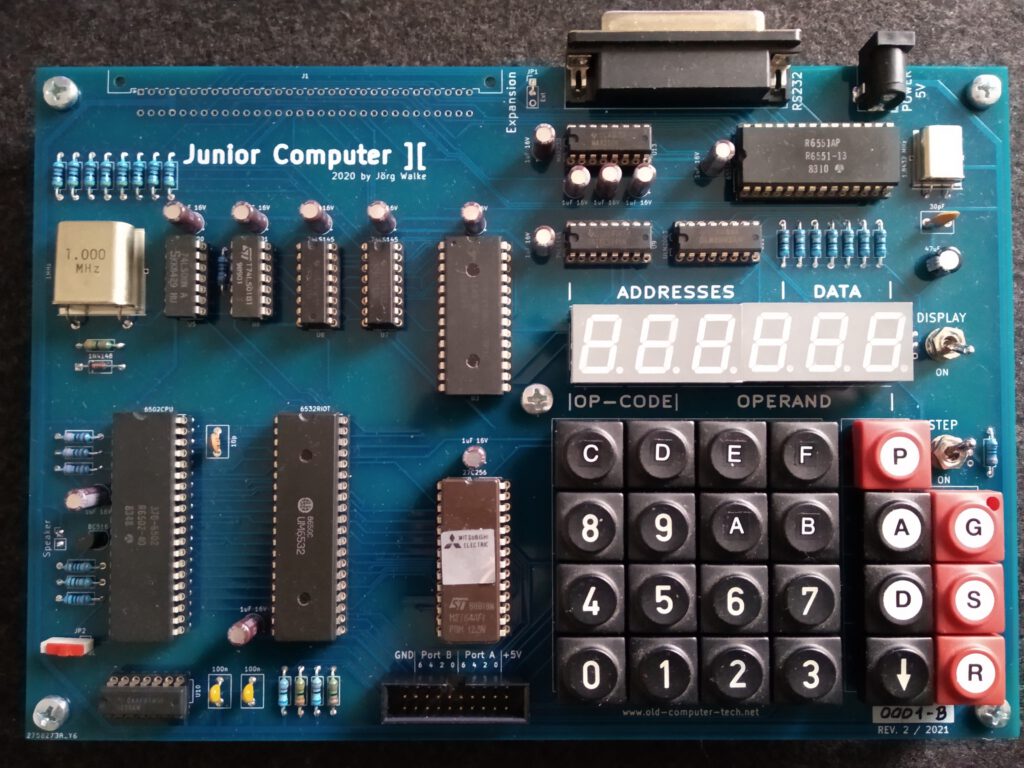 On the picture above, you can see the actual rev. 2 board of the Junior Computer ][.The new revision 3 board has arrived!
On the picture above, you can see the actual rev. 2 board of the Junior Computer ][.The new revision 3 board has arrived! …all components assembled and soldered
…all components assembled and soldered …and it works fine!
…and it works fine!
See also:
KIM-1 connectors: beware the Chinese cheap variants!
Magazines: Compute! and Compute II
All documents in the MTU pages are now clean and higher quality, about 50 new PDFs.
Focal-65 V3D for TIM and KIM-1

Junior Computer ][
Junior Computer ][
Written by 2021 by Joerg Walke, visit his website for the most actual version!
The Junior Computer ][ is an expanded version of the original Junior Computer. To make it more useful, I’ve equipped it with 32KB RAM, 8KB ROM and an onboard RS232 serial interface for connecting a terminal or a printer. For the use with a terminal, I also wrote an extended monitor program thats included in the bigger ROM. The development of the Junior Computer ][ is still in progress, so some other features will find its way to the mainboard.

On the picture above, you can see the actual rev. 2 board of the Junior Computer ][.
The new revision 3 board has arrived!

…all components assembled and soldered

…and it works fine!
Its new features are: Up to 128KB RAM chips installable. 3 DIP switches to configure three additional 8KB RAM banks. Maximum of 51712 Bytes usable with 64KB RAM chip. Auto reset at power on. A power switch (oh yeah). Usable Memory for string buffers in the address area of the ACIA.
Edit August 2022: there is now also a I/O card and a bus card!
The Computer is divided into two parts. On the left side are the main computer components. The 6502 CPU, 6532 RIOT (RAM, Input/Output and Timer), ROM (8 KB EPROM), RAM (32 KB SRAM), the 1MHz quarz cristal and some 74LSxx logic chips for address decoding and clock generation. There is also a double timer chip on the lower left corner for debouncing the Reset (R) and Stop (S) keys. On the top lies the (in the picture not populated) expansions connector. And on the bottom side there is a connector for the two 8 Bit I/O ports coming from the 6532 RIOT. A small transistor amplifier on port B0 can be used to drive a loudspeaker, to make some simple noise.
The input/output components of the Junior are on the right side of the PCB. There is the hexadecimal keyboard, for entering the program addresses and data. And there are also some control keys. Above the keyboard is the six-digit, 7-segment display for showing the addresses and the data bytes as hexadecimal coded numbers. The display can also be switched off, if not needed. Keyboard and display is controlled by the two 8-bit I/O ports of the RIOT, by alternately polling the keyboard and repeatedly writing each single digit of the data to be shown on the display. On the top of the I/O side is the 6551 ACIA (Asynchronous Communications Interface Adapter) chip and a level shifter for the RS232 serial interface signals. The little quarts aside the ACIA is for the baud rate generation, which ranges from 50 to 19200 Baud.
I built the first prototype in July 2020 on a breadboard, followed by the rev. 1 PCB in August 2021.
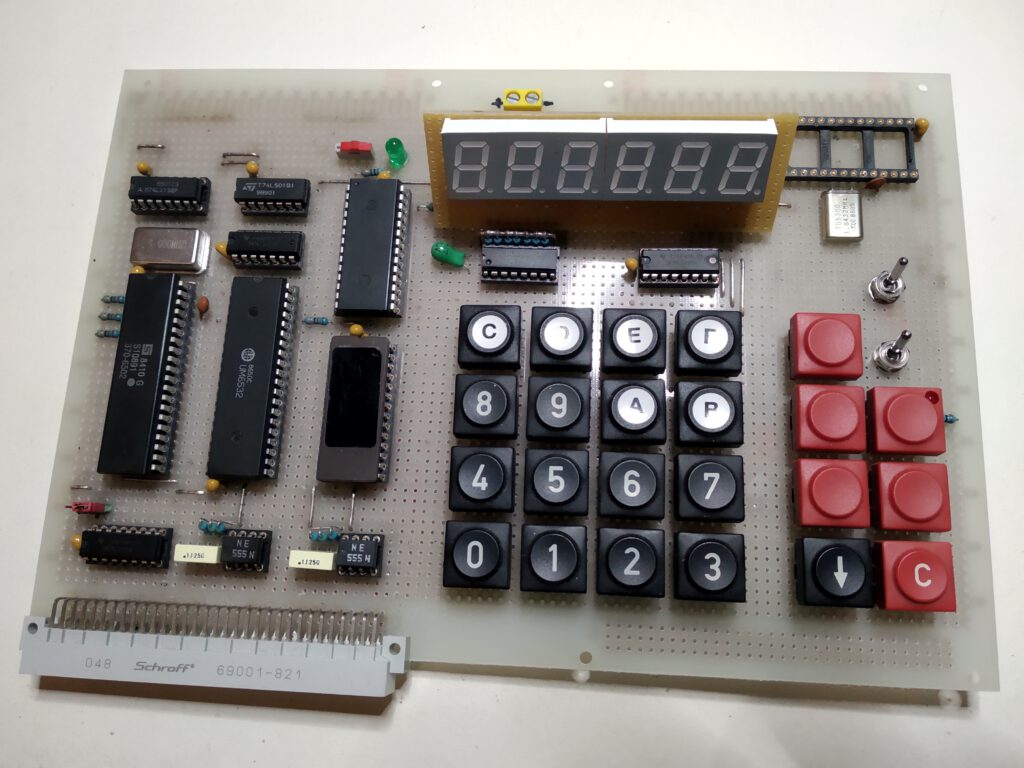
The rev. 2 board was necessary, because unfortunately the distances between the input keys were a little bit too narrow. Also the rev. 2 board had some issues. But it worked fine for me. After publishing the JC][ on the Classic Computing forum (www.classic-computing.de), I found some people who were interested in it. That charged me to make some further expansions and to make it a little bit more useful for others. The revision 3 board with some improvements is now on the way, as is new software.
The schematics and Gerber files for the PCB and of course the ROM images and the 6502 Assembler source code files are freely available on the download section. So feel free, to make your own Junior ][ and have some fun with 8 bits.
Programming the Junior Computer ][
Programming the Junior is quite simple:
Apply power and press the (R)eset switch. The display turns on and shows a random memory address (four digits) and its content (two digits). The Junior Computer ][ and its predecessor are both programmed in raw 6502 machine language. That is, each CPU command is entered in its numeric representation as a hexadecimal number. For example, 4c 00 F8 means: Jump (4C) to absolute location F800. 16-bit values such as memory addresses are written as the lowest byte first, so the byte representation 34 12 in memory represents the 16-bit value 1234 in hexadecimal.
To enter some data, you first have to type the address, were the data should be located. To do so, press the (AD)dress key and type in the four hexadecimal digits (16 bits) of the memory address location. Then press the (DA)ta key and type the two hexadecimal digits (8 bits) of the data. If you make a mistake, simply type in the new value. To enter data in the immediately following address, press the + Key (in my picture above, this is the down arrow key – because I just hadn’t a + keycap) and enter the new data.
To examine any address, you just have to press the (AD)dress key again and type in the address you want to visit. By pressing the + key, the direct successor address is displayed. Pressing the GO key executes the program at the currently displayed memory address. There is also a Edit mode where you can insert and delete data, and automatically calculate branch and jump addresses. To use this mode, please refer to the Junior Computer Book 2.
Another way to enter programs is, to use the extended (terminal) print monitor program. First you have to connect a VT100 compatible terminal to the RS232 interface and set it to
9600 Baud, 8 data bits, no parity, 1 stop bit
To start the monitor program, press the (AD)dress key, type in the address F800 and press GO. On the terminal display, you should now see something like this:
Junior Computer ][ Print Monitor 2021 by Joerg Walke (M)onitor (L)oad (S)ave (A)ssembler (B)asic ?
For now Monitor is the only selectable choice (but the rest will come soon, hopefully), so type M on the terminal keyboard to enter the Hex Monitor. The Display is cleared and a * prompt is shown. All input is non case sensitive, so typeing M or m is the same.
To examine the content of a single address, just type in the address as a hexadecimal number and press the Return key. The address and its current content is then shown.
*F800 F800- 4C
To view a hole block of data, enter the start-address and the end-address of the block to be shown, divided by a . (dot).
*F800.F808 F800- 4C DC F8 A4 F8 B1 F6 E6 F808- F8
To enter new data, type in the address where the data should be written, followed by a : (colon), followed by the single data bytes.
*200: 4C 00 F8 0200- 03
Execute a program by typing the start address followed by a G
*0200G 0200- 4C
To exit the Monitor and to go back to the main screen of the monitor type
*X
and then press the Return key.
If you want to go back to the standard Junior Monitor just enter
*1C1DG
(followed by Return) which leaves the terminal screen as a Zombie without a function and enables the 7-segment display and the hex keyboard.
That’s it. If you are interested in learning more about programming the 6502 and the Junior Computer, please refer to the MOS 6502 Datasheet and the Junior Computer books.
Downloads Junior Computer ][
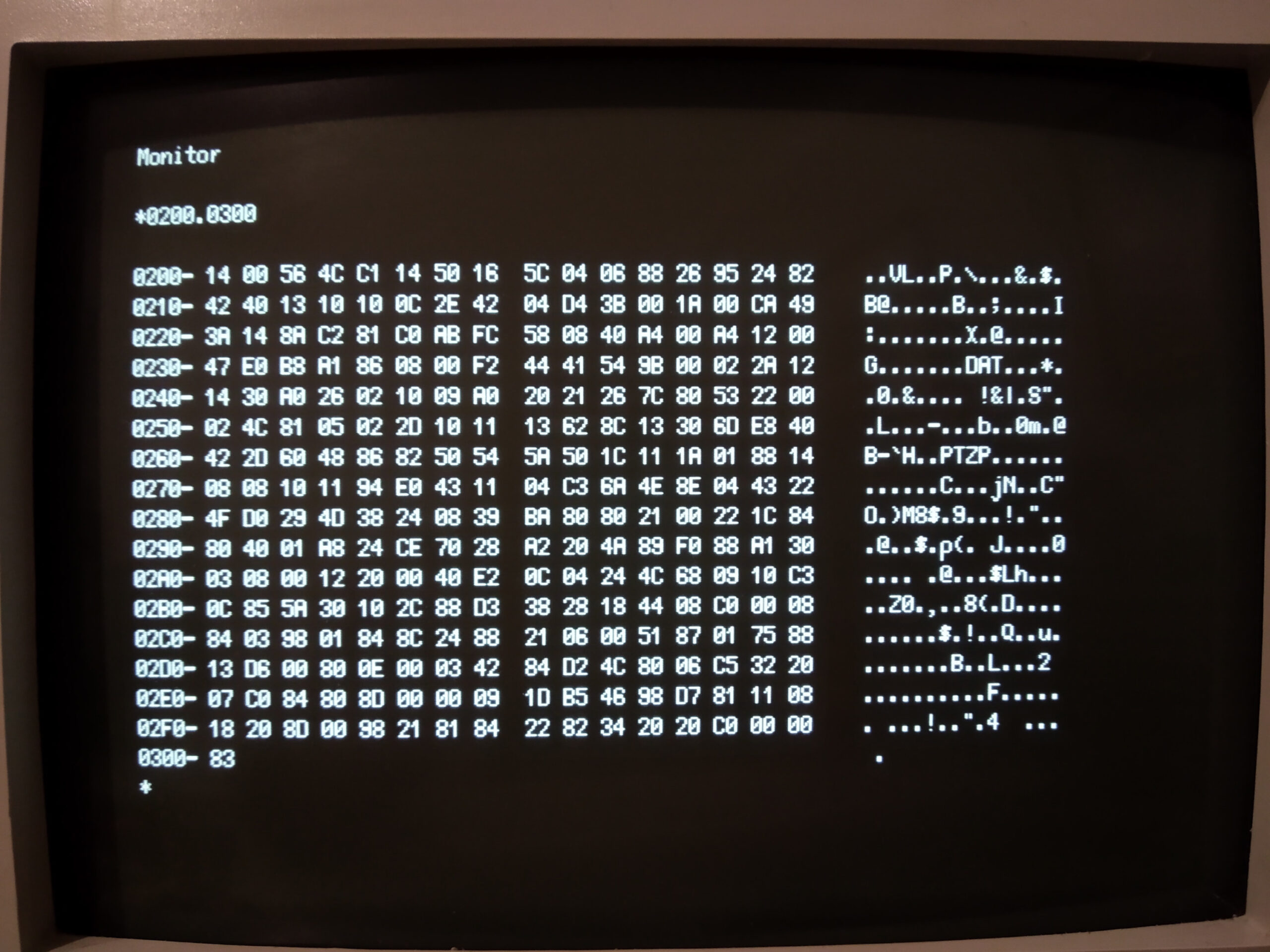
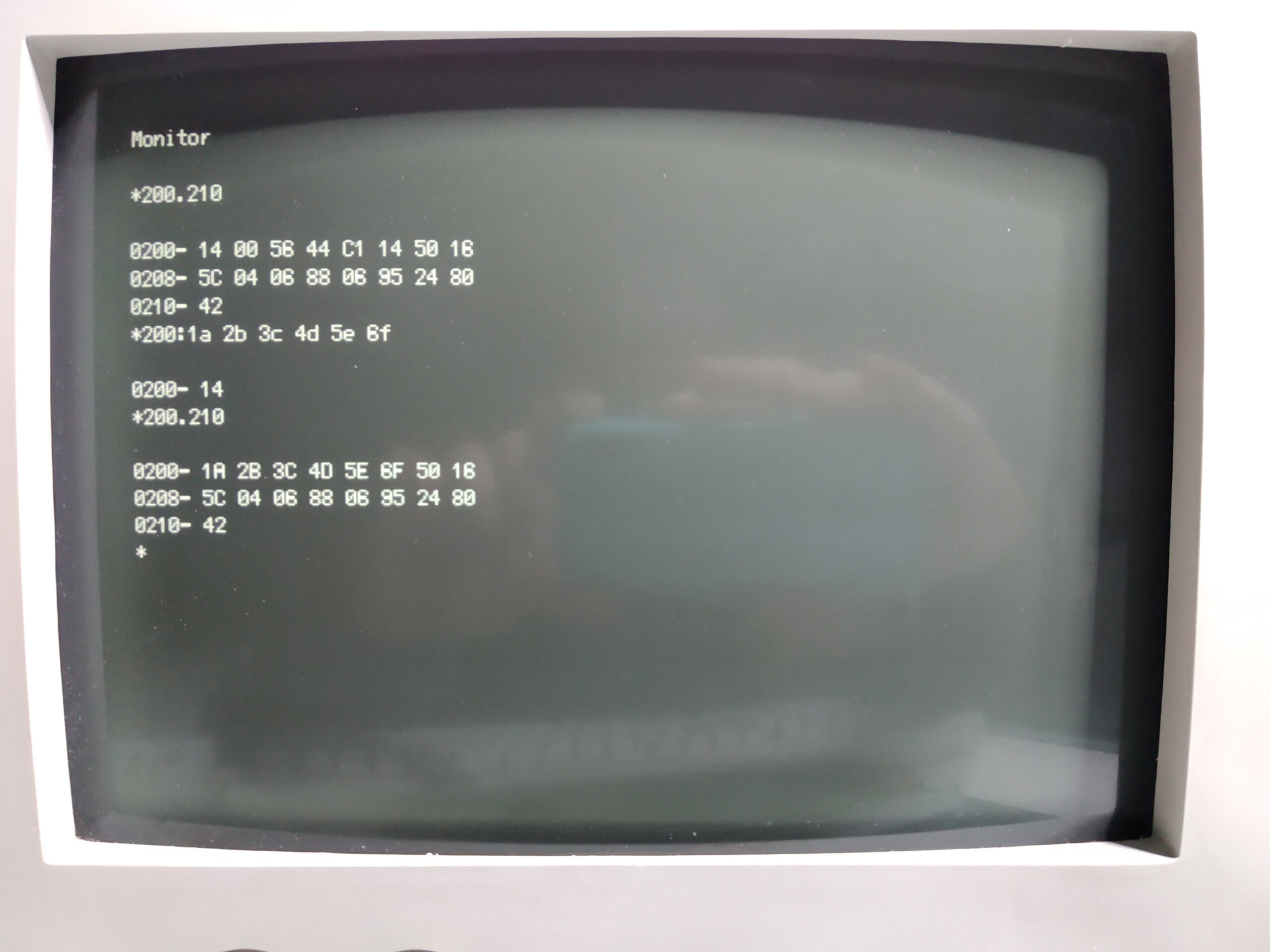
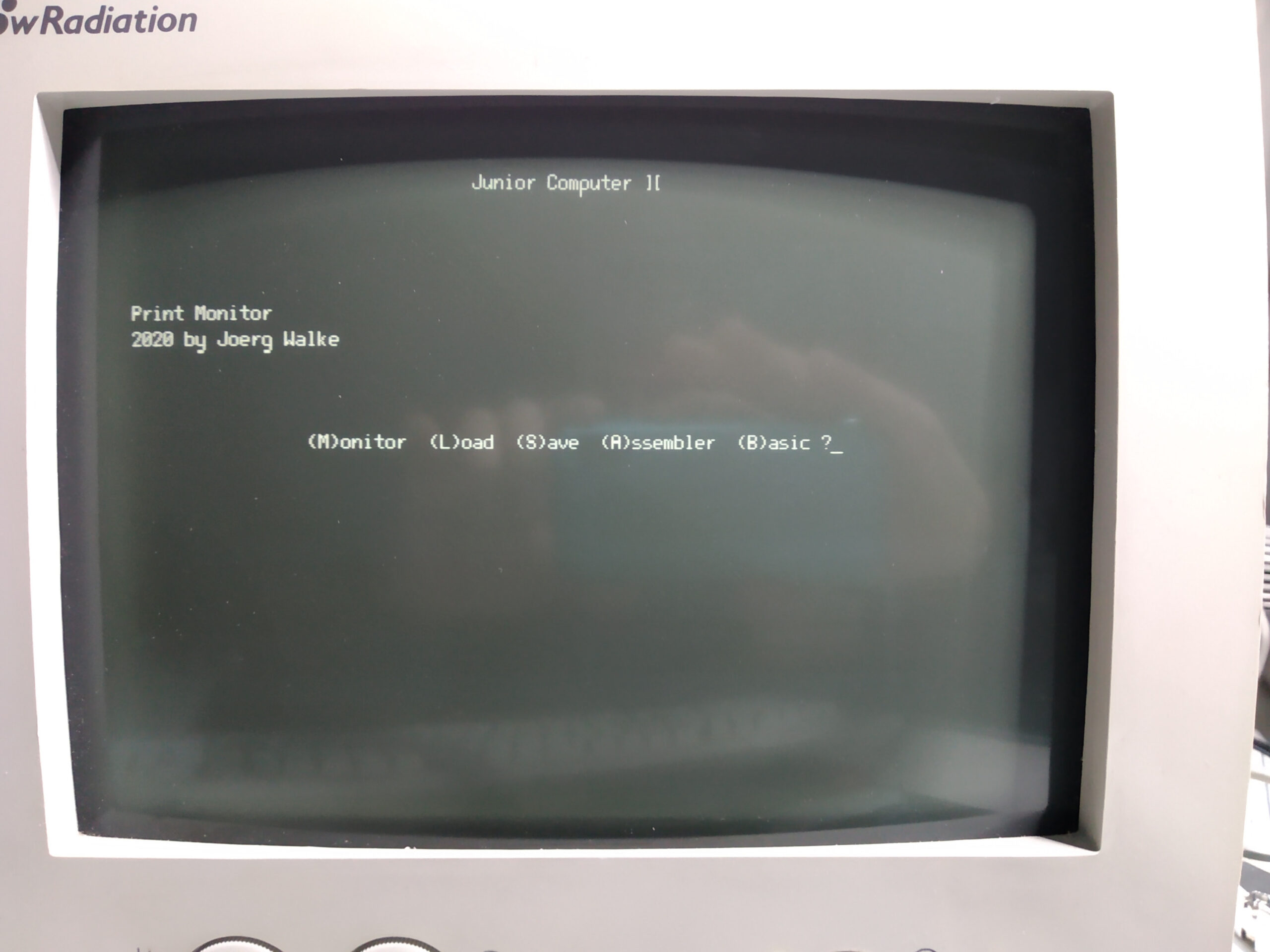
See also:
History of the TIM in the Jolt
Jolt software
Images of the Jolt
Jolt with a 74154 decoder
New SBC: SYM-1
I have acquired a SYM-1 Rev 1.1. Again a historical milestone back in my collection.
It works, so much more advanced software than a KIM-1, with more I/O and 4K memory.
No Basic or RAE ROMs alas.
See the Synertek SYM-1 pages for more info.


